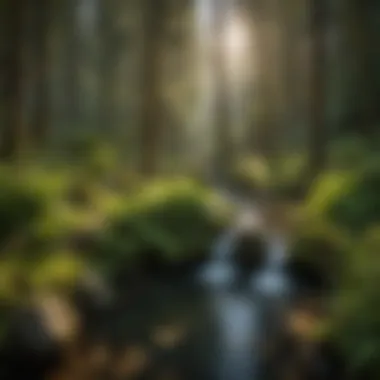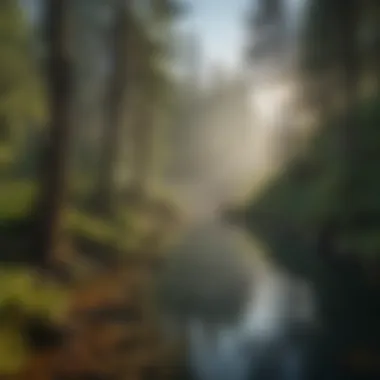Exploring Umpqua Hot Springs: A Comprehensive Guide


Intro
Umpqua Hot Springs, nestled in Oregon's Umpqua National Forest, is a captivating site characterized by its unique geological features. This natural phenomenon draws visitors not only for its therapeutic waters but also for its integration within a rich environmental context. The area is framed by towering evergreen trees and diverse wildlife, making it a sanctuary for nature enthusiasts and those seeking solace.
As we explore the various aspects of Umpqua Hot Springs, we will uncover the history, geology, and ecology of the springs, alongside practical advice for visitors aiming to experience this natural treasure responsibly.
"Conservation of natural resources like Umpqua Hot Springs is not just an obligation but an opportunity to honor our surroundings while enjoying their beauty."
Understanding the delicate balance of this ecosystem is key to ensuring its sustainability for future generations. This guide aims to provide comprehensive insights into Umpqua Hot Springs while highlighting its significant role in the ecological landscape of the region.
Intro to Umpqua Hot Springs
Umpqua Hot Springs, nestled within the Umpqua National Forest of Oregon, offers a unique interplay between nature, recreation, and wellness. Understanding this region and its hot springs is crucial for both visitors and researchers. This guide aims to provide comprehensive insights about the hot springs, including their geographical context and accessibility.
The natural formations of Umpqua not only serve as a source of relaxation but also represent a geological and ecological treasure trove. Exploring Umpqua Hot Springs means appreciating the surrounding landscape, rich history, and diverse ecosystem. A thorough understanding of the hot springs allows for improved enjoyment of the experience and fosters greater responsibility toward conservation efforts.
Geographical Location
Umpqua Hot Springs is situated in southern Oregon, within the vast expanse of the Umpqua National Forest. This location is characterized by its rugged terrain, dense forests, and river valleys. The hot springs sit at an elevation that provides beautiful views of the surrounding wilderness. The specific coordinates are approximately 43.3373° N latitude and 122.8519° W longitude.
This geographical setting offers not just aesthetic value but also influences the thermal properties of the springs. The mineral content of the water is greatly shaped by the geological formations found in the area. Umpqua Hot Springs is easily accessible from major highways, making it a prime spot for visitors seeking both adventure and relaxation.
Accessibility and Transportation
Accessibility to Umpqua Hot Springs can be straightforward. The nearest urban area is Roseburg, roughly 50 miles to the southwest. To reach Umpqua Hot Springs, one can primarily take Highway 138.
Once on Highway 138, drivers will turn onto Forest Service Road 34, which leads into the heart of the Umpqua National Forest. This road presents winding turns and some elevation changes, typical of the region. Travelers should exercise caution, especially in adverse weather conditions.
- Transportation options include:
- Personal vehicles, which provide the most flexibility.
- Ridesharing services may be an option in urban centers, but they are limited further out.
- Local public transport is available but may not reach the hot springs directly.
It's wise for visitors to plan their trip ahead of time, considering factors like road conditions and weather forecasts. For those interested in outdoor activities, a high-clearance vehicle is recommended, especially if exploring nearby trails.
Visiting Umpqua Hot Springs requires a respectful understanding of its accessibility and transportation options for a smooth experience.
Geological Features
Understanding the geological features of Umpqua Hot Springs is essential for discerning its uniqueness. The hot springs are not just a natural wonder; they represent a blend of geological history and current processes that shape our environment. These features provide insights into the thermal activity of the Earth, the chemical compositions of the waters, and even the broader ecological implications on surrounding flora and fauna.
Origin of the Hot Springs
The origin of Umpqua Hot Springs can be traced to the heated geothermal activity beneath the surface. This activity arises from magma bodies found deep within the Earth. As groundwater seeps down through the soil, it encounters heated rocks, which elevate its temperature. This process leads to the formation of hot springs. In the case of Umpqua, the interplay of geological formations creates a unique environment where mineral-rich water emerges, providing therapeutic benefits.
Umpqua Hot Springs is situated in a part of the Umpqua National Forest where significant geological forces have been at work for thousands of years. The presence of volcanic rock, significant fault lines, and hydrothermal systems contributes to the thermal activity observed in the area. Additionally, the hot springs are a vivid representation of the ongoing geothermal energy that characterizes the Pacific Northwest.
Thermal Properties of the Water
The thermal properties of the water at Umpqua Hot Springs merit attention for both their scientific and recreational significance. The water temperature can reach between 90 to 110 degrees Fahrenheit, depending on various factors like season and rainfall.
The water's chemical composition is also noteworthy, containing various minerals such as calcium, magnesium, and sulfates. These minerals are thought to provide various health benefits, including improved skin conditions and muscular relaxation. Understanding these properties allows visitors to appreciate not just the beauty of the springs, but also the potential health implications associated with soaking in the hot waters.
The unique blend of minerals in the hot springs can lead to a rich therapeutic experience, making it a desirable location for visitors seeking natural healing methods.


In summary, the geological features of Umpqua Hot Springs not only define its physical allure but also its ecological systems. By fully grasping the origins and the thermal properties of the springs, one can appreciate their significance in the broader context of environmental conservation and personal well-being.
Historical Context
The historical context surrounding Umpqua Hot Springs is essential in understanding its significance both to the local community and to visitors. Umpqua Hot Springs is more than just a natural wonder; it embodies a rich tapestry of cultural, historical, and environmental narratives that have evolved over centuries. Recognizing this context can enrich one’s experience and appreciation of the area.
Cultural Significance
The cultural significance of Umpqua Hot Springs cannot be overstated. Indigenous peoples of the region have long used these springs for their therapeutic properties, integrating the hot springs into their cultural and spiritual practices. For many Native American tribes, such as the Umpqua tribe, the hot springs symbolize connection to the earth, help in healing rituals, and communal gatherings.
In recent times, the springs have attracted diverse visitors seeking rest and rejuvenation, forming a bridge between a rich past and modern leisurely pursuits. This cultural evolution emphasizes the need to respect the traditions of these first nations while enjoying the natural beauty.
Development and Preservation
The development of Umpqua Hot Springs has involved a delicate balance between making the site accessible to the public and preserving its integrity. In the late 20th century, structures were built to accommodate visitors, including rustic soaking tubs and basic amenities. However, this development has not come without consequences. Increased foot traffic has contributed to potential environmental degradation and a strain on local ecosystems.
Efforts to address these challenges have fostered preservation initiatives. Local management agencies, along with community partners, engage in educational programs promoting responsible usage among visitors. They aim to protect the natural environment while providing guidelines to maintain the health of the springs.
"Conservation is not merely about protection; it is about creating a sustainable balance between human activity and nature's delicate ecosystems."
This ongoing commitment to preservation ensures that Umpqua Hot Springs can continue to be appreciated for generations to come.
Ecological Importance
The ecological importance of Umpqua Hot Springs is profound and multifaceted. This region serves as a unique habitat for a diverse array of flora and fauna, each playing a critical role in the health of the ecosystem. The hot springs create a specialized environment that supports unique species, contributing to the overall biodiversity. Understanding the delicate balance maintained within this ecosystem emphasizes the need for responsible stewardship and conservation efforts.
Surrounding Flora
The vegetation around Umpqua Hot Springs is rich and varied. Lush greenery flourishes in this humid environment, dominated by hardwood and coniferous trees. Species such as Douglas fir, western hemlock, and red alder are common. The understory consists of diverse shrubs, ferns, and herbaceous plants adapted to moist conditions. Some notable plant species include the Pacific rhododendron and various types of moss, which thrive in the organic-rich soil.
These plants contribute to soil stability and prevent erosion, while also providing habitat and food for various animals. The unique thermal environment created by the hot springs fosters certain plant adaptations, allowing them to live in areas that might be inhospitable to other species.
Fauna of the Umpqua Region
The fauna in the Umpqua region is equally diverse and forms a vital component of the local ecosystem. Animals that inhabit the area include both terrestrial and aquatic species. Mammals such as black bears, elk, and deer roam the landscape, while smaller mammals like raccoons and squirrels frequent the vicinity of the hot springs.
Birdlife in the area is plentiful, with species such as the great blue heron and various songbirds often spotted. Additionally, the hot springs provide a habitat for amphibians and reptiles, including frogs and salamanders, which thrive in warm, moist conditions. Each of these animals plays a role in their ecological niche, contributing to the health and stability of the overall ecosystem.
Biodiversity Considerations
Biodiversity in the Umpqua Hot Springs area is essential for several reasons. It enhances ecosystem resilience, allowing it to withstand environmental changes. A diverse ecosystem also supports a variety of food webs and contributes to the region's overall health. Human activity and climate change pose significant threats to this biodiversity; thus, it is vital to prioritize conservation efforts.
Key considerations for maintaining biodiversity include:
- Habitat Protection: Protecting the habitats of native species is crucial for sustaining biodiversity.
- Monitoring Human Impact: Environmental studies can identify how activities such as hiking and camping affect local species.
- Restoration Projects: Initiatives aimed at restoring native vegetation and habitats can help recover the region's ecological integrity.
The ecological importance of Umpqua Hot Springs highlights the interdependence of its flora and fauna, underlining the necessity for informed conservation efforts to preserve this unique and precious ecosystem.
Visitor Experience
Understanding the visitor experience at Umpqua Hot Springs is crucial for both enjoyment and conservation. This area is not just a place to relax; it offers an intricate blend of natural beauty, wellness benefits, and recreational opportunities. For many visitors, the experience transcends mere enjoyment; it becomes a part of their connection to nature. A thoughtful engagement with this natural resource can lead to a deeper appreciation for the environment and the importance of sustainable practices.
Amenities Available


Umpqua Hot Springs provide a variety of amenities designed to enhance the visitor experience. First and foremost, the hot springs themselves are the primary draw. The pools, which vary in temperature, allow visitors to choose their preferred level of warmth. Each bath offers a unique setting amid the natural landscape. In addition to the mineral-rich waters, nearby facilities add to the comfort of the visit.
- Restroom Facilities: Basic restroom facilities are in place, which can greatly enhance the comfort of visitors.
- Parking Options: Ample parking is available, allowing easy access to the springs.
- Picnic Areas: Designated picnic spots enable guests to enjoy meals surrounded by nature.
- Natural Trails: Several trails nearby facilitate exploration of the surrounding environment, making it easy to appreciate the landscape.
Activities and Recreation
Umpqua Hot Springs are not only about soaking in the mineral waters; they also serve as a hub for various recreational activities. Engaging in these activities can enhance the overall experience and appreciation of the area.
Visitors can engage in numerous activities, such as:
- Hiking: The surrounding forest is rich with trails suitable for various skill levels. Hiking through Umpqua National Forest allows visitors to witness the stunning ecology and diverse plant life.
- Photography: With breathtaking scenery and unique geological formations, the area presents excellent opportunities for photographers.
- Wildlife Viewing: The region hosts a range of species. Birdwatching and wildlife observation can be rewarding for nature enthusiasts.
- Guided Tours: For those seeking a more structured experience, local guides offer tours that delve deeper into the geological and ecological significance of the hot springs.
In summary, the visitor experience at Umpqua Hot Springs is multifaceted, blending relaxation, recreation, and connection to the environment. By understanding the available amenities and activities, visitors can enhance their time at this remarkable location, while being mindful of their impact on the ecosystem.
Responsible Usage of Hot Springs
Responsible usage of hot springs is critical for maintaining the delicate balance of the ecosystem around Umpqua Hot Springs. Visitors have the ability to influence this natural area positively or negatively. Awareness about this impact is crucial not just for preserving the springs themselves but also for ensuring that future generations can enjoy their natural beauty and the benefits they offer.
The unique geology and incredible natural features of Umpqua Hot Springs draw many visitors each year. However, as the number of visitors increases, the risk of potential environmental harm also rises. Hot springs can easily be damaged by litter, pollution, and improper usage. Therefore, understanding the environmental impact of one's actions when visiting these natural wonders is foundational to responsible usage.
Environmental Impact
The environmental impact of visiting hot springs encompasses a variety of factors. High foot traffic can lead to soil erosion and the compaction of surrounding vegetation. This not only disrupts sensitive habitats but also can lead to increased sedimentation in waterways. Additionally, improper disposal of waste can contaminate the water, affecting both human health and local wildlife.
Some specific concerns include:
- Soil Erosion: This becomes significant in areas with heavy foot traffic. It can alter the landscape and make it more difficult for plants to grow.
- Water Contamination: Harmful substances, especially from personal care products or food waste, can leach into the hot springs,
- Wildlife Disturbance: Increased noise and human activity may drive away local fauna, jeopardizing their presence in the ecosystem.
"A healthy ecosystem is vital for the longevity of natural features like hot springs. This benefits not only the environment but also enhances visitor experience."
Best Practices for Visitors
When visiting Umpqua Hot Springs, following best practices for responsible use can help minimize adverse effects. These practices can serve as a guideline for visitors:
- Stay on Designated Trails: This will prevent further damage to ecological habitats and minimize erosion.
- Pack Out What You Pack In: Visitors should ensure they leave no trace. This includes not only trash but also any personal items that may be left behind.
- Use Eco-Friendly Products: When bathing, select biodegradable soaps and shampoos to limit harmful substances from entering the water.
- Observe Wildlife from a Distance: This prevents them from feeling threatened and maintains their natural behaviors.
- Follow Local Regulations: Always adhere to the guidelines set by managing agencies, ensuring that conservation efforts are supported.
By embracing these practices, visitors can enjoy Umpqua Hot Springs while also playing a role in preserving its beauty for the future.
Conservation Efforts
The conservation of Umpqua Hot Springs is essential for maintaining its natural beauty and ecological integrity. Preserving this unique resource ensures that future generations can enjoy both its recreational benefits and its ecological significance. Through effective management and community involvement, the delicate balance between human activity and environmental stewardship can be achieved. Conserving hot springs helps to protect the surrounding ecosystem and maintain the water quality, which is vital not only for user experience but also for local wildlife.
Moreover, conservation efforts promote awareness about the impacts of tourism on natural resources. Educating visitors about the specific behaviors that support preservation can lead to a more sustainable approach to enjoyment of these hot springs. Awareness campaigns can highlight the consequences of littering, off-trail hiking, and other practices that may harm the delicate ecosystem.
Local Management Initiatives
Local management initiatives play a pivotal role in the conservation of Umpqua Hot Springs. The Umpqua National Forest management collaborates with conservation groups to implement strategies that minimize the environmental impact of visitors. These initiatives often involve periodic assessments of the area's environmental conditions, adjustments to access routes, and maintenance of facilities to ensure they meet ecological standards.
Significant actions include:
- Monitoring visitor numbers to assess the capacity of the site.
- Establishing access regulations aimed at protecting sensitive areas.
- Implementing signage and information boards that educate upon arrival.
Through these efforts, local management aims to mitigate detrimental effects while promoting responsible usage of the hot springs. It creates a balance that respects both nature and visitors.


Community Engagement
Community engagement is vital in the successful conservation of Umpqua Hot Springs. Involving local residents and stakeholders nurtures a sense of ownership and responsibility towards the hot springs. Various community programs seek to connect citizens with their natural surroundings and reinforce the importance of preserving this vital resource.
Examples of community engagement strategies include:
- Volunteer clean-up events, where locals can participate in maintaining the beauty of the hot springs.
- Educational workshops that teach sustainable practices and environmental awareness.
- Partnerships with local organizations that focus on conservationist ideals.
Engaging the community not only raises awareness but also helps to foster a culture of environmental responsibility. This collective effort can ensure that Umpqua Hot Springs remains a treasured natural resource, enjoyed sustainably by current and future visitors.
Effective conservation requires a collaboration between management and the community, creating a shared vision for preserving natural wonders like Umpqua Hot Springs.
Common Questionss about Umpqua Hot Springs
When planning a visit to Umpqua Hot Springs, potential visitors often have questions that can provide invaluable insights. These FAQs serve to illuminate the key aspects of the hot springs experience. Understanding what to expect enhances the overall enjoyment and allows for better preparation. Questions about accessibility, amenities, and regulations can significantly affect visitor satisfaction. Moreover, addressing health and safety concerns ensures responsible tourism near these natural features.
What to Expect Upon Arrival
Upon reaching Umpqua Hot Springs, visitors will find a unique blend of nature and communal experience. The first aspect to notice is the landscape. The springs are tucked away in the lush Umpqua National Forest, surrounded by tall trees and varied wildlife. The journey to the springs often involves a short hike, which sets the tone for the natural serenity that follows.
Visitors should come prepared for an informal and rustic setting. Facilities at the springs are limited, consisting primarily of small, natural pools. The water temperature in these pools can fluctuate, so it is advisable to bring a thermometer if temperature is a concern. It is important to be aware of other guests. Respecting privacy and maintaining a peaceful atmosphere adds to everyone's enjoyment.
Here are some tips for what to expect:
- Parking: Limited spots are available, so arrive early.
- Hiking: The walk to the springs can be steep in places, wear sturdy shoes.
- Crowds: Expect varying levels of visitors, especially during peak seasons.
- Facilities: There are no public restrooms. Plan accordingly.
Health Benefits of Visiting Hot Springs
Visiting hot springs can provide numerous health benefits, fostering both physical and mental wellness. The mineral-rich waters at Umpqua Hot Springs are particularly known for their therapeutic properties. Here are a few benefits often associated with such natural thermal waters:
- Relaxation: The warm water helps to reduce stress and promote relaxation.
- Muscle Relief: Soaking can alleviate muscle tension and soreness, beneficial for hikers and outdoor enthusiasts.
- Skin Health: Minerals such as sulfur can aid in skin healing and may benefit conditions like eczema.
- Improved Circulation: Warm water promotes better blood flow, which can enhance overall cardiovascular health.
Given these benefits, it is essential to enjoy the springs mindfully. Those with pre-existing health conditions should consult a medical professional before soaking.
"The calming effect of Umpqua Hot Springs significantly contributes to both mental and physical well-being, making it a sought-after destination for stress relief."
Overall, being informed about what to expect and understanding the health benefits adds value to the experience at Umpqua Hot Springs.
Culmination
In summary, the exploration of Umpqua Hot Springs is more than just a physical journey to a geothermal wonder. It embodies a deep appreciation for the natural world intertwined with historical and ecological dynamics. Understanding the layers of significance surrounding these hot springs allows visitors and locals alike to engage with them responsibly.
Recap of Key Points
The Umpqua Hot Springs offer unique geological features that reflect their origins and thermal properties. This article has highlighted crucial aspects, including:
- Geographical Location: Nestled in the Umpqua National Forest, making it accessible yet secluded.
- Historical Significance: Areas enriched with cultural heritage and historical context.
- Ecological Impact: Importance of surrounding flora and fauna, demonstrating biodiversity.
- Visitation Considerations: Practical guidance for visitors including amenities and best practices.
- Conservation Efforts: The ongoing initiatives aimed at preserving this natural resource and promoting sustainable usage.
These key points provide a robust understanding of Umpqua Hot Springs and the delicate balance that must be maintained to preserve its beauty and significance.
Final Thoughts on Conservation
Conservation is not merely a guideline; it is a necessity for maintaining the integrity of Umpqua Hot Springs. The interaction between human activity and natural ecosystems must be approached with caution. Sustainable practices help ensure that this vital resource remains intact for future generations.
Consider the following:
- Minimal Footprint: Visitors should aim to limit their environmental impact. This includes respecting local wildlife and plant life.
- Educating Others: Share knowledge about the importance of conservation with fellow visitors.
- Supporting Local Initiatives: Engage with community-driven conservation efforts to impact positively.
The future of Umpqua Hot Springs depends on the collective commitment to protect its natural and cultural wealth. By understanding and valuing this unique ecosystem, we contribute to its longevity and preserve its legacy.



